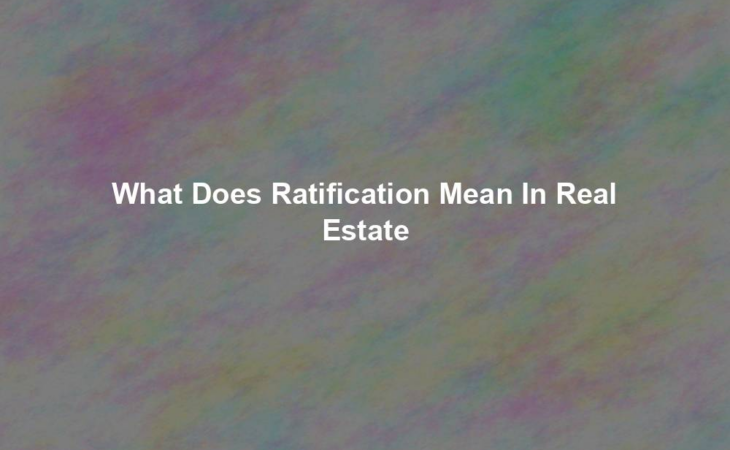
When it comes to real estate, the process of ratification plays a crucial role in sealing the deal. But what exactly does ratification mean in the context of real estate transactions? Well, it’s not just about signing a contract or completing a purchase. Ratification is the formal approval or acceptance of a contract or agreement by all parties involved, making it legally binding and enforceable. It signifies the moment when both the buyer and seller have reached a mutual agreement and have given their consent to move forward with the transaction.
Ratification in real estate carries significant weight as it ensures that all parties are in agreement and are committed to fulfilling their obligations. It provides a level of security and protection for both buyers and sellers, as they can trust that the terms and conditions outlined in the contract will be upheld. Without ratification, a contract may be deemed invalid, leaving all parties vulnerable to potential disputes or legal issues. Therefore, the process of ratification is a vital step in the real estate transaction process, providing clarity and peace of mind for everyone involved.
In real estate, ratification refers to the formal acceptance and approval of a contract or agreement. It occurs when all parties involved have agreed upon the terms and conditions of the transaction. Ratification is a crucial step that solidifies the validity and enforceability of the contract. It signifies that the parties intend to be bound by the terms outlined in the agreement. This process ensures that the real estate transaction progresses towards closing and legal obligations are met.
In the world of real estate, the term “ratification” holds significant importance. It refers to the act of validating or confirming a contract or agreement after it has been executed. Ratification plays a crucial role in ensuring the legality and enforceability of real estate transactions. Whether you’re a buyer, seller, or real estate professional, understanding the concept of ratification is essential to navigate the complexities of the industry. Let’s delve deeper into what ratification means in the context of real estate and how it impacts various parties involved.
Note: If you’re interested in gaining comprehensive knowledge about real estate contracts and agreements, Real Estate Contracts: A Complete Guide provides valuable insights.
In the realm of real estate, ratification occurs when all parties involved in a transaction accept and agree to the terms and conditions outlined in a contract. By ratifying a contract, each party acknowledges their intention to be bound by its terms, making the agreement legally valid and enforceable. Ratification typically takes place after both parties have signed the contract, signaling their acceptance and commitment to its terms.
Ratification can occur through various means, including verbal confirmation, written communication, or even through actions that imply acceptance. However, it’s important to note that ratification must be explicit and unequivocal. Both parties must fully understand the terms of the contract and the implications of ratifying it.
The process of ratification is crucial in real estate transactions as it establishes the foundation for a legally binding contract. Without ratification, a contract may be considered void or unenforceable, leaving both parties vulnerable to potential disputes and legal complications.
Ratification holds immense significance in the real estate industry due to the legal implications it carries. Here are a few reasons why ratification is essential:
Let’s explore the typical process of ratification in real estate transactions:
1. Offer and Acceptance: The process begins with the buyer submitting an offer to purchase a property. If the seller accepts the offer, it becomes a legally binding contract.
2. Negotiation and Counteroffers: There may be instances where the initial offer is not accepted as is. In such cases, negotiations and counteroffers take place until both parties reach an agreement.
3. Agreement on Terms: Once all parties have agreed on the terms, including the purchase price, contingencies, and any other conditions, the contract is ready for ratification.
4. Signing the Contract: All parties involved in the transaction, typically the buyer, seller, and their respective real estate agents or attorneys, sign the contract. This signifies their intention to be bound by its terms.
5. Ratification: After the contract is signed, it undergoes the ratification process. This involves a careful review of the contract by all parties to ensure their full understanding and agreement with its terms. Ratification is typically confirmed by the exchange of a ratified copy of the contract.
Contingencies are conditions or requirements that must be met for a contract to be fully ratified. These contingencies protect the interests of both buyers and sellers. Common contingencies in real estate contracts include:
Contingencies must be satisfied within the agreed-upon timeline for the contract to proceed to full ratification. If the contingencies are not met within the specified timeframe, the contract may be terminated or renegotiated.
Ratification is an integral part of the real estate process as it validates and solidifies the contractual agreements between buyers and sellers. By understanding the concept of ratification and the steps involved in the process, real estate professionals and individuals involved in real estate transactions can navigate the complexities of the industry with confidence. So, whether you’re a buyer, seller, or agent, make sure to familiarize yourself with the concept of ratification to ensure a smooth and successful real estate transaction.
For detailed insights into various aspects of real estate contracts and transactions, Real Estate Contracts: A Complete Guide provides valuable information.
In real estate, ratification refers to the formal approval or confirmation of a contract or agreement by all parties involved.
It signifies that all parties have agreed to the terms and conditions outlined in the contract, and it establishes the contract’s legal validity.